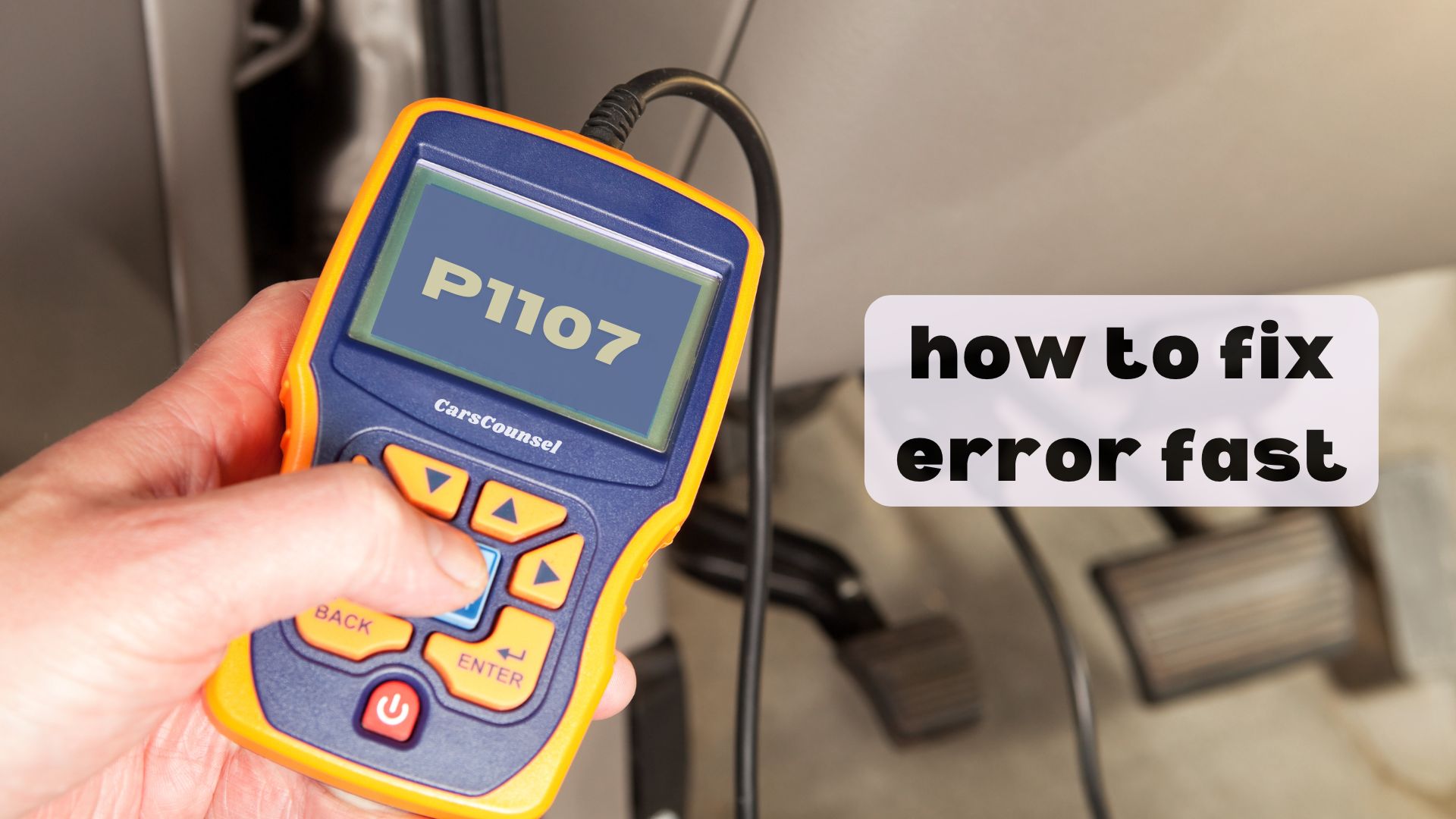Notably, over 20 major automotive brands have encountered the P1107 code, which signals a low voltage issue with the barometric pressure sensor. This sensor is essential for optimizing engine performance by adjusting the air-fuel mixture based on atmospheric pressure.
If you’re experiencing symptoms like reduced fuel efficiency or engine hesitation, it might be due to this issue. You’ll need to investigate further to pinpoint the cause and fix it effectively.

Quick Navigation
Key Takeaways
- P1107 code indicates a low voltage signal from the barometric pressure sensor.
- Faulty sensor or wiring issues cause incorrect atmospheric pressure readings.
- Symptoms include reduced fuel efficiency and engine hesitation.
- Diagnosis involves inspecting sensor and connections with a multimeter.
- Repair may require replacing the sensor and resetting the ECM.
Understanding the P1107 Code
When your vehicle’s engine control module (ECM) detects a low voltage signal from the barometric pressure sensor, it triggers the P1107 code.
This sensor plays an essential role in measuring atmospheric pressure, which is vital for calculating the air-fuel mixture. The barometric pressure sensor’s function is to provide accurate readings to the ECM, ensuring peak engine performance.
A faulty sensor can disrupt this process, leading to issues like reduced fuel efficiency and engine hesitation. Understanding this fault code helps you identify and address the problem effectively.
Causes of the P1107 Code
The P1107 code is triggered by a low voltage signal from the barometric pressure sensor, which is essential to maintaining ideal engine performance.
This sensor is vital for calculating air density and ensuring proper air-fuel mixtures. Voltage fluctuations can significantly impact engine efficiency and performance.
Common causes include:
- Faulty barometric pressure sensor: Incorrect readings lead to poor engine performance.
- Wiring issues or loose connections: These can cause voltage drops.
- Corrosion or damage to sensor connectors: This affects signal integrity and sensor function.
Symptoms of a Faulty Barometric Pressure Sensor
A faulty barometric pressure sensor can lead to several noticeable symptoms that affect your vehicle’s performance.
You may experience reduced fuel efficiency, rough idling, or engine stalling due to incorrect air-fuel mixture ratios.
Engine performance issues, such as hesitation or lack of power, are common. The Check Engine Light will likely illuminate, and emissions may increase.
These symptoms indicate that the barometric pressure sensor isn’t providing accurate data, impacting overall engine performance and potentially causing long-term damage if not addressed promptly.
Diagnosing the P1107 Code
Diagnosing the P1107 code involves a systematic approach to identify the cause of the low voltage in the barometric pressure sensor circuit.
You’ll need to inspect the sensor and its connections thoroughly.
Key diagnostic steps include:
- Voltage Testing: Use a multimeter to check the sensor’s output voltage.
- Sensor Calibration: Verify if the sensor needs recalibration.
- Wiring Inspection: Check for any wiring issues or loose connections.
Proper diagnosis is essential for effective repair.
Repairing the P1107 Code
Repairing the P1107 code requires a methodical approach to address the low voltage issue in the barometric pressure sensor circuit.
You’ll start by using a diagnostic scan tool to confirm the fault. Next, inspect the wiring and connectors for damage or corrosion.
Perform voltage testing with a multimeter to verify the sensor’s output. If necessary, proceed with sensor replacement.
After replacing the sensor, reset the ECM and conduct a test drive to verify the issue is resolved.
This process helps restore peak engine performance.
Costs Associated With Fixing the P1107 Code
Fixing the P1107 code involves several costs that you should consider. The total cost can range from $150 to $350, depending on the vehicle and location.
Here are key expenses:
- Sensor Replacement: A new barometric pressure sensor costs between $50 and $150.
- Labor Costs: Additional $100 to $200 for professional installation.
- Repair Estimates: Consult a mechanic for accurate estimates tailored to your vehicle’s make and model.
Preventing Future Issues
To prevent future issues with the barometric pressure sensor circuit, it’s crucial to maintain your vehicle’s electrical and intake systems regularly.
Perform preventive maintenance by inspecting wiring and connectors for damage or corrosion. Confirm sensor calibration is accurate to avoid incorrect readings.
Regularly check for vacuum leaks in the intake system, as these can affect sensor performance.
By addressing these areas, you can reduce the likelihood of future P1107 codes and maintain peak engine performance.
Regular checks will help prevent costly repairs and guarantee your vehicle runs efficiently.
Troubleshooting Tips and Tricks
When troubleshooting a P1107 code, you’ll want to start by understanding that this issue involves a low voltage signal from the barometric pressure sensor, which can affect your engine’s air-fuel mixture and overall performance.
To effectively diagnose and fix the problem, consider these steps:
- Sensor Calibration: Confirm the sensor is properly calibrated to provide accurate readings.
- Voltage Testing: Use a multimeter to verify the sensor’s voltage output matches expected levels.
- System Inspection: Check for wiring issues, corrosion, or vacuum leaks that might be causing the low voltage signal.
More OBD-II Codes
| P1118 | P1119 | P1121 | P1122 |
| P1123 | P1124 | P1125 | P1126 |
| P1127 | P1128 | P1129 | P1130 |
| P1132 | P1133 | P1134 | P1136 |
| P1135 | P1147 | P1148 | P1149 |
| P1150 | P1032 | P1153 | P1154 |
Frequently Asked Questions
Can P1107 Affect Vehicle Safety?
You can assess if sensor calibration issues affect vehicle safety by considering how they impact safety protocols. Incorrect sensor readings might not directly compromise safety protocols but can lead to performance issues that indirectly affect vehicle safety.
Does P1107 Impact Engine Performance?
When diagnosing engine performance issues, you’ll find that faulty sensor calibration can significantly impact it. In the context of engine diagnostics, a low voltage signal from a sensor like the barometric pressure sensor can lead to improper air-fuel mixtures, affecting engine performance.
Is P1107 Specific to Certain Vehicles?
When you’re “in the driver’s seat,” P1107 isn’t specific to one vehicle type; it affects various models like Acura, Audi, and Ford, involving different sensor types, including those integrated into the ECM.
Can P1107 Be Caused by Other Sensor Issues?
You can determine if other sensor issues cause a problem by checking sensor compatibility and using diagnostic procedures. Faults in related sensors might trigger similar codes, so it’s essential to verify each sensor’s functionality.
Does P1107 Require Immediate Repair?
You’re probably thrilled to see that check engine light. Seriously, though, P1107 doesn’t require immediate repair, but it’s wise to address it soon to avoid performance issues. Perform diagnostic procedures to assess repair urgency.
Conclusion
You’ve successfully diagnosed and repaired the P1107 code related to the barometric pressure sensor circuit low voltage. Some might argue that replacing the sensor is unnecessary if the issue is intermittent, but it’s essential for maintaining ideal engine performance and fuel efficiency. By ensuring proper sensor function and wiring, you’ll prevent future issues like reduced engine performance and increased emissions. Regular checks can help prevent similar problems.

